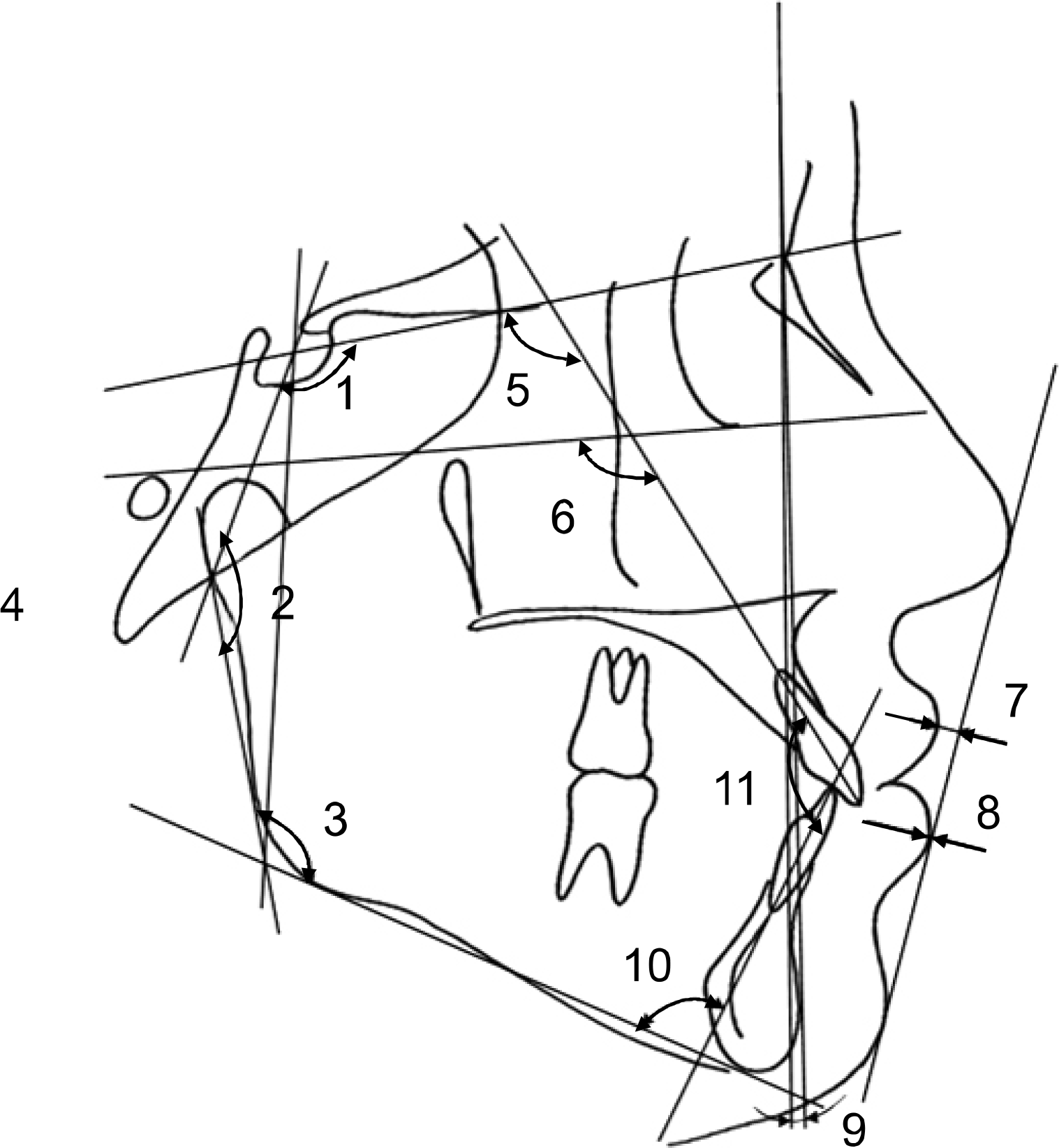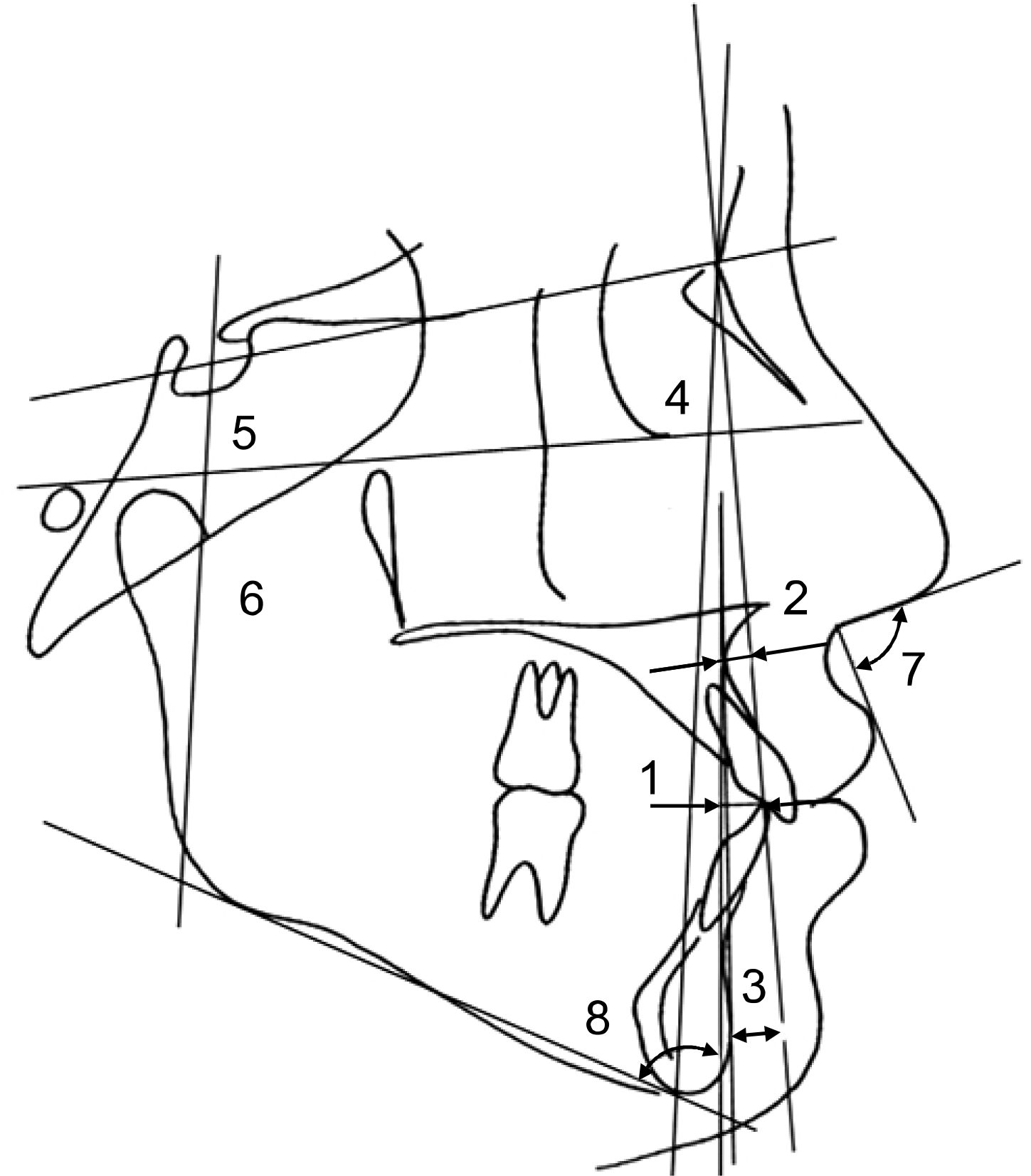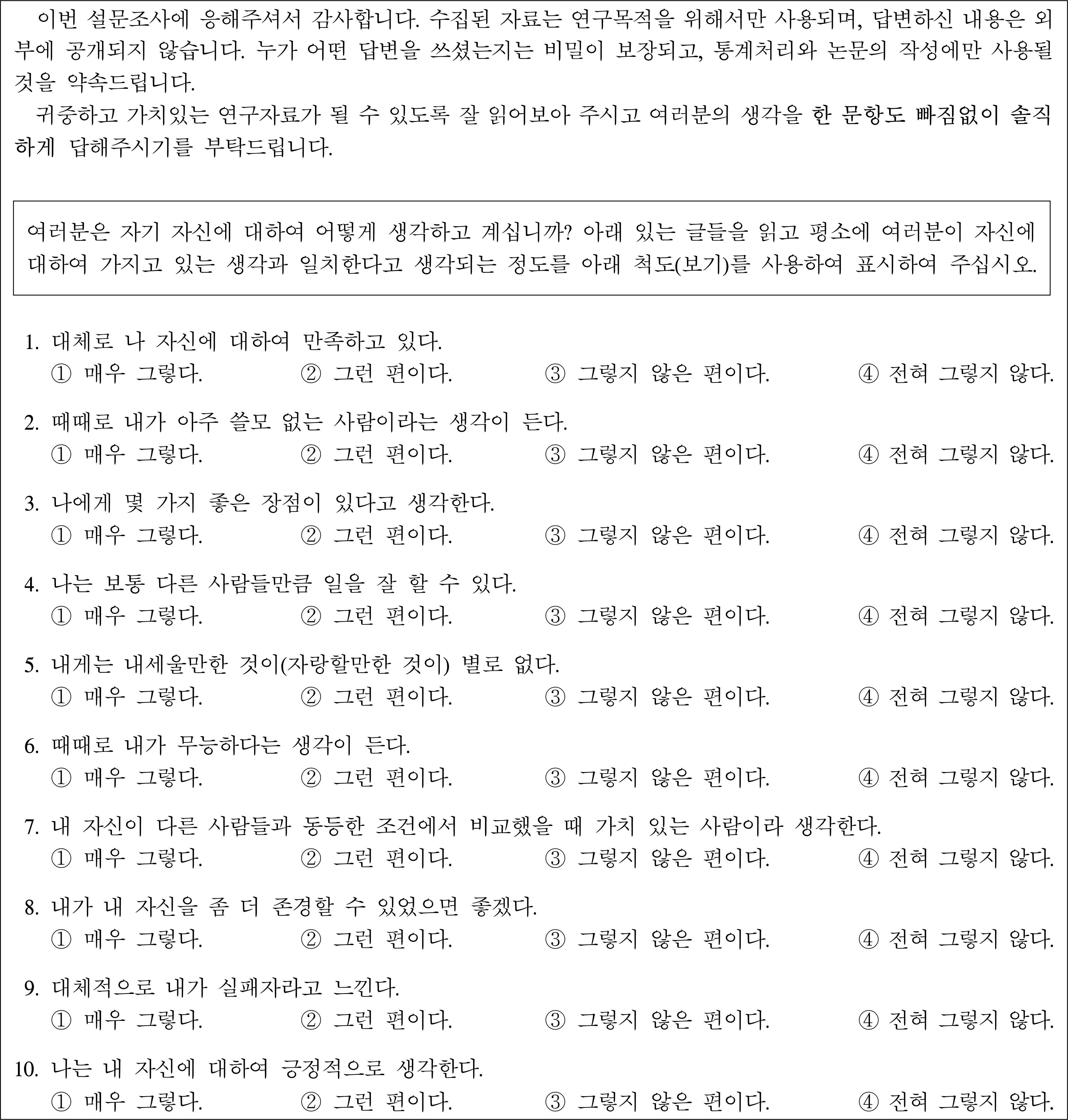Abstract
Objective:
The purpose of this study was to evaluate the effects of malocclusion on the self-esteem of female university students.
Methods:
The subjects were composed of 67 female university students who showed Class I molar relation, no missing or supernumerary teeth and has had no orthodontic treatment experience. Each subject was evaluated with Rosenberg's Self-esteem Scale to measure the level of self-esteem and also evaluated the degree of anterior crowding and lip protrusion through model analysis and cephalometric soft tissue profile analysis.
Go to : 
REFERENCES
1.Centofante DM., Brittin ME., Williams BH. Anterior malocclusion and soft tissue profile related to sound production and self-concept. Angle Orthod. 1982. 52:313–24.
2.Jung MH. Effects of malocclusion and orthodontic treatment on the self-esteem of adolescents. Korean J Orthod. 2007. 37:56–64.
3.Shaw WC., Meek SC., Jones DS. Nicknames, teasing, harassment and the salience of dental features among school children. Br J Orthod. 1980. 7:75–80.

4.Lagerström L., Stenvik A., Espeland L., Hallgren A. Outcome of a scheme for orthodontic care: a comparison of untreated and treated 19-year-olds. Swed Dent J. 2000. 24:49–57.
5.Thompson LA., Malmberg J., Goodell N., Boring RL. The distribution of attention across a talker's face. Discourse Process. 2004. 38:145–68.

6.Arndt EM., Travis F., Lefebvre A., Niec A., Munro IR. Beauty and the eye of the beholder: social consequences and personal adjustment for facial patients. Br J Plast Surg. 1986. 39:81–4.
7.Klages U., Bruckner A., Guld Y., Zentner A. Dental esthetics, orthodontic treatment, and oral-health attitudes in young adults. Am J Orthod Dentofacial Orthop. 2005. 128:442–9.

8.Van der Geld P., Oosterveld P., Van Heck G., Kuijpers-Jagtman AM. Smile attractiveness. Self-perception and influence on personality. Angle Orthod. 2007. 77:759–65.
9.An JY., An K., O'Connor L., Wexler S. Life satisfaction, self-esteem, and perceived health status among elder Korean women: focus on living arrangements. J Transcult Nurs. 2008. 19:151–60.

10.Brody GH., Kogan SM., Murry VM., Chen YF., Brown AC. Psychological functioning, support for self-management, and glycemic control among rural African American adults with diabetes mellitus type 2. Health Psychol. 2008. 27(Suppl 1):83S–90S.

11.Ogden J., Lindridge L. The impact of breast scarring on perceptions of attractiveness: an experimental study. J Health Psychol. 2008. 13:303–10.
12.Crystal DS., Watanabe H., Weinfurt K., Wu C. Concepts of human differences: a comparison of American, Japanese and Chinese children and adolescents. Dev Psychol. 1998. 34:714–22.

13.Reichmuth M., Greene KA., Orsini MG., Cisneros GJ., King GJ., Kiyak HA. Occlusal perceptions of children seeking orthodontic treatment: impact of ethnicity and socioeconomic status. Am J Orthod Dentofacial Orthop. 2005. 128:575–82.

14.Brown KM., McMahon RP., Biro FM., Crawford P., Schreiber GB., Similo SL, et al. Changes in self-esteem in black and white girls between the ages of 9 and 14 years. The NHLBI Growth and Health Study. J Adolesc Health. 1998. 23:7–19.
15.Shaw WC., Richmond S., Kenealy PM., Kingdon A., Worthington H. A 20-year cohort study of health gain from orthodontic treatment: psychological outcome. Am J Orthod Dentofacial Orthop. 2007. 132:146–57.

16.Kerosuo H., Al Enezi S., Kerosuo E., Abdulkarim E. Association between normative and self-perceived orthodontic treatment need among Arab high school students. Am J Orthod Dentofacial Orthop. 2004. 125:373–8.

17.Tulloch JF., Shaw WC., Underhill C., Smith A., Jones G., Jones M. A comparison of attitudes toward orthodontic treatment in British and American communities. Am J Orthod. 1984. 85:253–9.

18.Mandall NA., Wright J., Conboy FM., O'Brien KD. The relationship between normative orthodontic treatment need and measures of consumer perception. Community Dent Health. 2001. 18:3–6.
19.Arnett GW., Bergman RT. Facial keys to orthodontic diagnosis and treatment planning. Part I. Am J Orthod Dentofacial Orthop. 1993. 103:299–312.

20.Little RM. The irregularity index: a quantitative score of mandibular anterior alignment. Am J Orthod. 1975. 68:554–63.

21.Rosenberg M. Society and the adolescent self-image. Middletown: Wesleyan University Press;1989.
22.Seo YK. Relationships between adolescents' appearance satisfaction and self-esteem and academic achievement [thesis]. Seoul: Sookmyung Women's Univ;2003.
23.Park HK. Self-serving bias in the evaluation of personal change over time [thesis]. Seoul: Seoul National Univ;2002.
24.Garcia SD. Appearance anxiety, health practices, meta-perspectives and self-perception of physical attractiveness. J Soc Behav Personal. 1998. 13:307–18.
25.Dion K., Berscheid E., Walster E. What is beautiful is good. J Pers Soc Psychol. 1972. 24:285–90.

26.Langlois J., Kalakanis L., Rubenstein A., Larson A., Hallam M., Smoot M. Maxims or myths of beauty? A meta-analytic and theoretical review. Psychol Bull. 2000. 126:390–423.

28.Adams GR. Physical attractiveness research. Toward a developmental social psychology of beauty. Hum Dev. 1977. 20:217–39.
29.Clifford MM., Walster E. The effects of physical attractiveness on teacher expectation. Sociol Educ. 1973. 46:248–58.
30.Adams GR., La Voie JC. The effects of student's sex, conduct, and facial attractiveness on teacher expectancy. Educ. 1974. 95:76–83.
31.Landy D., Sigall H. Beauty is talent: task evaluation as a function of the performer's physical attractiveness. J Personality Soc Psychol. 1974. 29:299–304.

32.Kiyak HA., Hohl T., Sherrick P., West RA., McNeil RW., Bucher F. Sex differences in motives for and outcomes of orthognathic surgery. J Oral Surg. 1981. 39:757–64.
33.Holmes A. The subjective need and demand for orthodontic treatment. Br J Orthod. 1992. 19:287–97.

34.Muijs RD. Predictors of academic achievement and academic self-concept; a longitudinal perspective. Br J Educ Psychol. 1997. 67:263–77.

35.Korean association of orthodontics malocclusion white paper publication committee. Cephalometric analysis of normal occlusion in Korean adults. Korean Association of Orthodontists:. 1997.
36.Jung MH., Yang WS. Causative factors and predictability of arch length discrepancy. Korean J Orthod. 1997. 27:457–71.
37.Kelly JE., Harvey CR. An assessment of the occlusion of the teeth of youths 12-17 years. Vital Health Stat 11. 1977. 162:1–65.
Go to : 
 | Fig 1.Cephalometric measurements. 1, Saddle angle; 2, articular angle; 3, gonial angle; 4, Bjork sum (1+2+3); 5, upper 1 to SN; 6, upper 1 to FH; 7, upper lip to E line; 8, lower lip to E line; 9, ANB; 10, IMPA; 11, interincisal angle. |
 | Fig 2.Cephalometric measurements (continued). 1, Lower 1 to A Pog; 2, A to N perpendicular; 3, Pog to N perpendicular; 4, anterior facial height (N to Me); 5, posterior facial height (S to Go); 6, facial height ratio (5/4 x 100); 7, nasolabial angle; 8, AB to mandibular plane. |
Table 1.
Grouping of the samples by types of malocclusion
Table 2.
Irregularity index and lip protrusion values of each group (Mean ± Standard deviation)
| Group | Irregularity index | Lip protrusion (UL + LL) |
|---|---|---|
| 1 | 2.61±1.30 | −1.20±3.09 |
| 2 | 10.86±3.21 | −0.36±3.40 |
| 3 | 2.96±1.49 | 6.88±2.21 |
Table 3.
Mean and standard deviation of the measurements of each group
| Measurement | Group | ANOVA | ||
|---|---|---|---|---|
| 1 | 2 | 3 | ||
| Age (yr) | 22.60±2.94 | 21.61±3.09 | 23.58±3.92 | NS |
| Björk sum | 394.37±4.44 | 397.56±5.72 | 400.59±6.77 | (1,2)(2,3)∗ |
| Facial Ht ratio | 65.99±3.24 | 64.28±5.19 | 61.85±4.80 | (1,2)(2,3)∗ |
| ANB | 2.31±2.00 | 4.09±2.18 | 4.38±1.85 | (1)(2,3)∗ |
| A to N-perp | −0.35±3.63 | 0.71±3.01 | 0.47±3.34 | NS |
| Pog to N-perp | −4.68±5.38 | −7.74±6.98 | −9.97±6.96 | (1,2)(2,3)∗ |
| U1 to FH | 114.85±4.81 | 115.26±8.63 | 116.06±6.47 | NS |
| U1toSN | 106.67±5.42 | 106.82±8.35 | 106.89±6.71 | NS |
| L1toA-Pog | 4.92±1.80 | 4.89±2.45 | 7.70±2.59 | (1,2)(3)∗ |
| IMPA | 95.67±6.75 | 95.17±7.25 | 97.30±6.46 | NS |
| InterincisalA. | 123.37±6.91 | 120.73±10.17 | 115.31±7.98 | (1,2)(3)∗ |
| ABtoMP | 70.88±6.49 | 70.93±5.63 | 68.99±5.59 | NS |
| NasolabialA. | 102.42±12.96 | 96.65±9.88 | 99.55±12.84 | NS |
Table 4.
Self-esteem index (SI) of each group
| Group | N | SI (Mean±SD) | Post hoc∗ | Order |
|---|---|---|---|---|
| 1 | 23 | 3.11±0.29 | A | |
| 2 | 22 | 2.86±0.28 | B | A>B |
| 3 | 22 | 2.75±0.34 | B | |
| Total | 67 | 2.91±0.33 |




 PDF
PDF ePub
ePub Citation
Citation Print
Print



 XML Download
XML Download